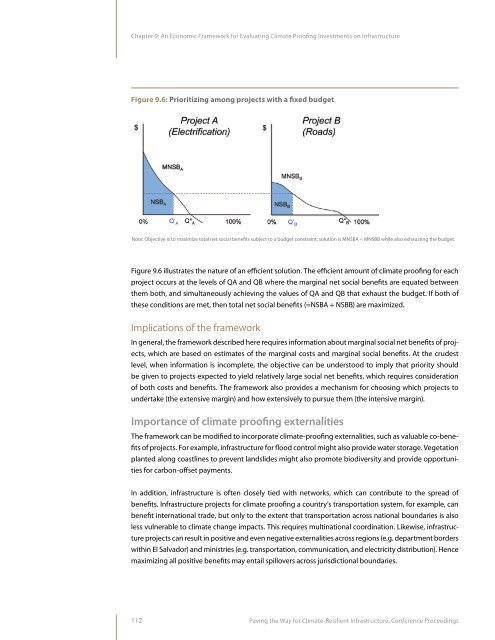Paving the Way for Climate-Resilient Infrastructure - UN CC:Learn
Paving the Way for Climate-Resilient Infrastructure - UN CC:Learn
Paving the Way for Climate-Resilient Infrastructure - UN CC:Learn
You also want an ePaper? Increase the reach of your titles
YUMPU automatically turns print PDFs into web optimized ePapers that Google loves.
Chapter 9: An Economic Framework <strong>for</strong> Evaluating <strong>Climate</strong> Proofing Investments on <strong>Infrastructure</strong>Figure 9.6: Prioritizing among projects with a fixed budgetNote: Objective is to maximize total net social benefits subject to a budget constraint; solution is MNSBA = MNSBB while also exhausting <strong>the</strong> budget.Figure 9.6 illustrates <strong>the</strong> nature of an efficient solution. The efficient amount of climate proofing <strong>for</strong> eachproject occurs at <strong>the</strong> levels of QA and QB where <strong>the</strong> marginal net social benefits are equated between<strong>the</strong>m both, and simultaneously achieving <strong>the</strong> values of QA and QB that exhaust <strong>the</strong> budget. If both of<strong>the</strong>se conditions are met, <strong>the</strong>n total net social benefits (=NSBA + NSBB) are maximized.Implications of <strong>the</strong> frameworkIn general, <strong>the</strong> framework described here requires in<strong>for</strong>mation about marginal social net benefits of projects,which are based on estimates of <strong>the</strong> marginal costs and marginal social benefits. At <strong>the</strong> crudestlevel, when in<strong>for</strong>mation is incomplete, <strong>the</strong> objective can be understood to imply that priority shouldbe given to projects expected to yield relatively large social net benefits, which requires considerationof both costs and benefits. The framework also provides a mechanism <strong>for</strong> choosing which projects toundertake (<strong>the</strong> extensive margin) and how extensively to pursue <strong>the</strong>m (<strong>the</strong> intensive margin).Importance of climate proofing externalitiesThe framework can be modified to incorporate climate-proofing externalities, such as valuable co-benefitsof projects. For example, infrastructure <strong>for</strong> flood control might also provide water storage. Vegetationplanted along coastlines to prevent landslides might also promote biodiversity and provide opportunities<strong>for</strong> carbon-offset payments.In addition, infrastructure is often closely tied with networks, which can contribute to <strong>the</strong> spread ofbenefits. <strong>Infrastructure</strong> projects <strong>for</strong> climate proofing a country’s transportation system, <strong>for</strong> example, canbenefit international trade, but only to <strong>the</strong> extent that transportation across national boundaries is alsoless vulnerable to climate change impacts. This requires multinational coordination. Likewise, infrastructureprojects can result in positive and even negative externalities across regions (e.g. department borderswithin El Salvador) and ministries (e.g. transportation, communication, and electricity distribution). Hencemaximizing all positive benefits may entail spillovers across jurisdictional boundaries.112<strong>Paving</strong> <strong>the</strong> <strong>Way</strong> <strong>for</strong> <strong>Climate</strong>-<strong>Resilient</strong> <strong>Infrastructure</strong>: Conference Proceedings
















